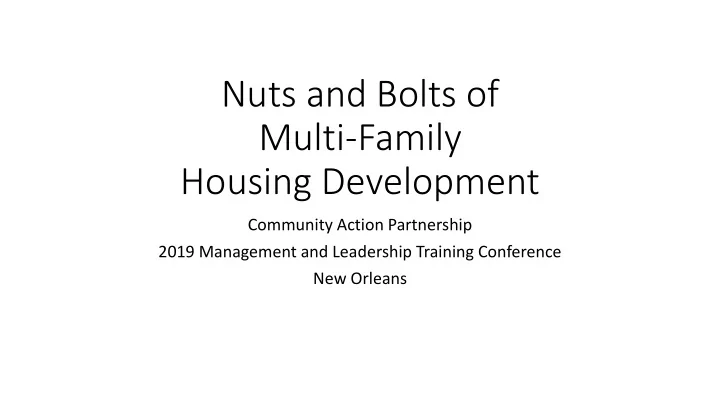

Nuts and Bolts of Multi-Family Housing Development Community Action Partnership 2019 Management and Leadership Training Conference New Orleans
Overview • What to think about before starting out • Finding the right location • Pre-development • Financing your project • Resources
What to ask before starting out? • Is it needed? • Market studies, market rent vs affordable rentals, scale • How can we finance it? • Are we patient enough? • It can easily take 3 years from start to finish for a LIHTC funded project • Do we have the capital, or access to the capital, for start up costs? • Option/purchase, A/E fees, permits, other due diligence • Can we weather the financial storms after it is built? • You’ll likely own it for decades with restrictive covenants. Operational losses can happen. • Do we have the right team?- Internal and external (A/E, attorney, etc) • Who will you partner with? • If just starting out, partner with exp. developer with track record that will give funders confidence.
What to do before starting out Trainings – for your team and your board Run the numbers • Make sure development and operating budgets pencil out • http://apps.urban.org/features/cost-of-affordable-housing/ Talk to existing developers in your area/state – for trials, tribulations, tips & tricks Talk to municipalities – Do they want it, have land to give, tax deal, other support? Talk to funders – tips, pitfalls, expectations, timelines, etc. Talk to your board(s) to manage expectations – Years and money. Talk to real estate brokers – pricing, helping you find available sites/buildings Think about management – in house or 3 rd party?
Site Selection Start with the scoring – See where older projects are located and what they look like What market are you looking to serve? - Multifamily or senior, special population, proximity to services, schools, health care, public transportation, etc. Access to utilities – check capacity/location of system, site costs vs acq costs, growth area? Zoning and ordinances - limit variances, look at density, setbacks, etc early on. Environmental considerations – past uses, costs of clean up, timing. Additional information from municipality or consultants - find as much free information as you can Look years ahead, not just immediate needs, when talking to partners
NIMBYism • Can lay waste to best laid plans (and money) • Know the neighbors before you buy - Will they resist your idea? Don’t underestimate the power of a small group of neighbors • Choose your words carefully when speaking publically • Talk to local code and planning • Limit need for variances to limit potential legal battles • Make friends who will speak out in favor • Be ready to make concessions to appease neighbor’s concerns • Use trickery if concerned about “public” outcry
Pre-development • Assemble your team (if you haven’t already) – Pick firms or consultants who have done work in your town/area. Think about bank, A/E, environmental, attorney, etc • Work backwards from deadlines for permitting and approvals • Get firm prices for A/E, environmental, and other costs • Use existing designs to save cost and time • Speak to funder(s) as your project progresses/evolves – Check in & ask Q’s • Finalize property tax deal shortly after site control • Site control- timing, term and price
Designing your project • The building(s) – Orientation, layout, design, parking, etc. matter more than you think • Local permitting – Know the timing, expectations, and push back on paying for fixes that your design team should have known about • Deadlines and expectations of your design team – Set a timeline and stick to it • Operating budget – Use marketing study or new data to refine pricing and costs. 3 rd party management will have good data, too. • Development budget – Will be refined and updated regularly as new information comes in. Start with RS Means or other data, then look at local pricing data. Dig into estimates you receive from A/E team; ask questions, challenge assumptions. Date your versions.
Financing your project • LIHTC • Regional Home Loan Bank • State subsidy • CDBG • CRA • State debt • Deferred developer fee • Covering the gaps (hard debt)
Resources • Neighborworks • Novogradic • Your state’s housing authority • IPED • Other CAPs!
Questions? Jason Bird Penquis, CAP Bangor, Maine 207-973-3551 jbird@penquis.org
Recommend
More recommend